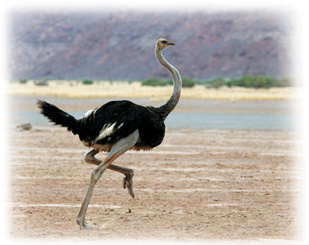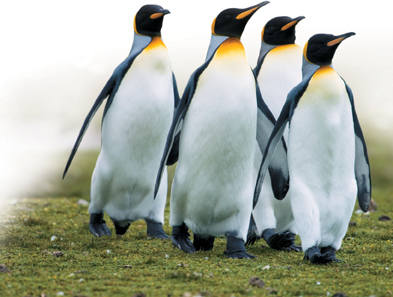Evolutionary classification of living birds is still a work in progress, as different techniques and analyses produce different results. There are about 10,000 species. The groups described below illustrate some of the diversity of birds.
PALEOGNATHAE: Ostriches, emus, kiwis, and relatives
This group represents an early branch of the bird family tree that is separate from all other living birds. This clade includes the largest birds alive today. Ostriches can be 2.5 meters tall and weigh 130 kilograms! Kiwis, however, are only about the size of chickens. Roughly a dozen living species are scattered throughout the Southern Hemisphere. All are flightless, but the larger species can run very fast. They generally eat a variety of plant material, insects, and other small invertebrates. Examples: Ostrich, emus, Brown Kiwi, Greater Rhea, Dwarf Cassowary

Ostrich
SPHENISCIDAE: Penguins
These flightless birds of the Southern Hemisphere are adapted to extreme cold and hunting in water. Though they cannot fly, they use their wings as flippers when they swim. Penguins have more feathers per square centimeter than any other bird; this density allows them to repel water and conserve heat effectively. Some species form large colonies. Examples: Emperor Penguin, Chinstrap Penguin, King Penguin

King Penguins
ANATIDAE: Ducks, geese, and swans
These birds spend much of their time feeding in bodies of water. Webbed feet enable them to paddle efficiently across the surface of the water. Most fly well, however, and many species migrate thousands of kilometers between breeding and resting locations. Examples: Redhead, Ross's goose, Trumpeter Swan

Redhead
Table of Contents
- Formulas and Equations
- Applying Formulas and Equations
- Mean, Median, and Mode
- Estimation
- Using Measurements in Calculations
- Effects of Measurement Errors
- Accuracy
- Precision
- Comparing Accuracy and Precision
- Significant Figures
- Calculating With Significant Figures
- Scientific Notation
- Calculating With Scientific Notation
- Dimensional Analysis
- Applying Dimensional Analysis




